Sweetsop
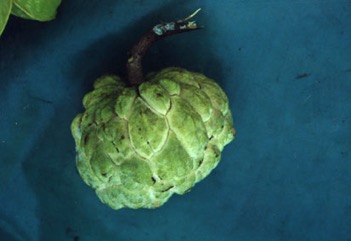
A tropical plant. It suits lowland drier climates. It grows naturally in the dry hills around Port Moresby in Papua New Guinea. The trees will probably grow satisfactorily up to about 1000 metres altitude in equatorial zones. In Colombia it grows between 340-1,300 m above sea level. Sweetsops cannot stand frost but they are able to survive droughts better than many fruit trees. Trees do not like waterlogged soils. Sweetsops can grow on fairly poor, dry, stony soils. In Bolivia they grow in areas with rainfall or 500-1,000 mm per year. It suits hardiness zones 10-12.
Also known as:
Ai piol, Anon morado, Anona, Anona montes, Anuune, Apeli, 'atis, Ata, Atafol, Ates, Atis, Atta, Attier, Awzar, Buah nona, Chhitaphal, Chirimoya crespa, Dawatsip, Dhivehi atha, Fat manaova, Fruta-do-conde, Gam ja, Juructira, Kaneelappel, Khieb, Kok khiap, Konikony, Lanang, Makhiap, Man cau ta, Moumou, Mphosa, Mstafeli, Mufa, Na, Nameana Noi-nah, Noina, Nona sri kaya, Pinha, Pomme cannelle, Ram phal, Rinon, Saramuyo, Sarifa, Sarikaja, Seetaphal, Shareefa, Sharifa, Sini-atta, Sirkaja, Sitafal, Sitaphal, Sita-phalo, Sitapalam, Sitappalm, Sittapan, Sri kaya, Sugar apple, Tiep baay, Tiep srok
Synonyms
- Annona asiatica L.
- Annona cinerea Dunal
- Annona distincta Raeusch.
- Annona forskalii DC.
- Guanabanus squamosus M. Gomez
- Xylopia glabra L.
- Xylopia frutescens Sieb. ex Presl.
Edible Portion
- Fruit
Where does Sweetsop grow?
Found in: Africa, Amazon, Andamans, Antigua and Barbuda, Antilles, Asia, Australia, Bangladesh, Bolivia, Brazil, Burkina Faso, Burundi, Cambodia, Cameroon, Cape Verde, Caribbean, Central Africa, Central America, China, Colombia, Congo DR, Cook Islands, Cuba, Dominican Republic, East Africa, East Timor, Ecuador, Fiji, French Guiana, Gabon, Ghana, Guadeloupe, Guam, Guatemala, Guianas, Guyana, Haiti, Hawaii, Himalayas, India, Indochina, Indonesia, Jamaica, Kenya, Kiribati, Laos, Madagascar, Malawi, Malaysia, Maldives, Mariana Islands, Marquesas, Martinique, Mexico, Mozambique, Myanmar, Nauru, Nepal, New Caledonia, Nicaragua, Niger, Northeastern India, North America, Pacific, Pakistan, Papua New Guinea, PNG, Peru, Philippines, Puerto Rico, Reunion, Rotuma, Sao Tome and Principe, Saudi Arabia, SE Asia, Seychelles, Sierra Leone, Solomon Islands, Somalia, South Africa, Southern Africa, South America, Sri Lanka, St. Kitts and Nevis, St. Vincent and Grenadines, Sudan, Suriname, Taiwan, Tanzania, Thailand, Timor-Leste, Tonga, Trinidad-Tobago, Tuvalu, Uganda, United States, Vanuatu, Venezuela, Vietnam, West Africa, West Indies, Yemen
Notes: There are about 100-150 Annona species. Chemicals in the seeds are being investigated as medicine. They have anticancer properties. The bark has chemicals against prostrate cancers.
Status: It is a cultivated fruit tree. It is popular. It is fairly common in coastal areas of Papua New Guinea especially near Port Moresby
Growing Sweetsop
Cultivation: They are normally grown from seeds and the seeds retain their viability for several years. It is better to grow sweetsops from fresh seeds and it is best to soak seeds for 3 days before sowing. Seeds germinate and start to grow 50 to 70 days after planting. The fruit is borne on old and new wood. As the fruit is more commonly on new wood, pruning is an advantage. Trees can be budded or grafted. A small branch of a selected variety is grafted onto another seedling sweetsop. Plants are very hard to get to grow from cuttings. A spacing of 6 m apart is suitable for sweetsop trees. The fruit is eaten raw. The sweet soft fleshy layer around the seeds can be eaten raw. When the fruit is ripe it is easy to separate the different soft fleshy parts of the fruit. Often it is easiest and best to harvest the fruit when they are nearly ripe and then let them ripen in a warm place.
Edible Uses: The fruit is eaten raw. It is also used in ice cream. The juice is used for drinks. CAUTION: The seeds, leaves and roots are poisonous. Both an alkaloid, and hydrocyanic acid have been shown to occur in these parts of the plant.
Production: The tree is slow growing. Trees can start to produce fruit 2 years after they are planted. A tree can produce 100 fruit. Fruit are often 200-300 g each. The pulp is 20% sugar.
Nutrition Info
per 100g edible portion| Edible Part | Energy (kcal) | Protein (g) | Iron (mg) | Vitamin A (ug) | Vitamin c (mg) | Zinc (mg) | % Water |
|---|---|---|---|---|---|---|---|
| Fruit | 106 | 2.09 | 0.6 | 1 | 40 | 0.1 | 76.4 |
Sweetsop Photos

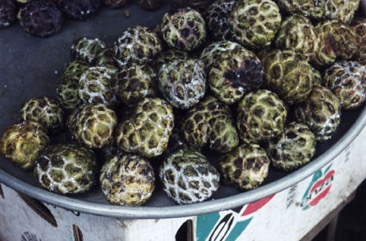
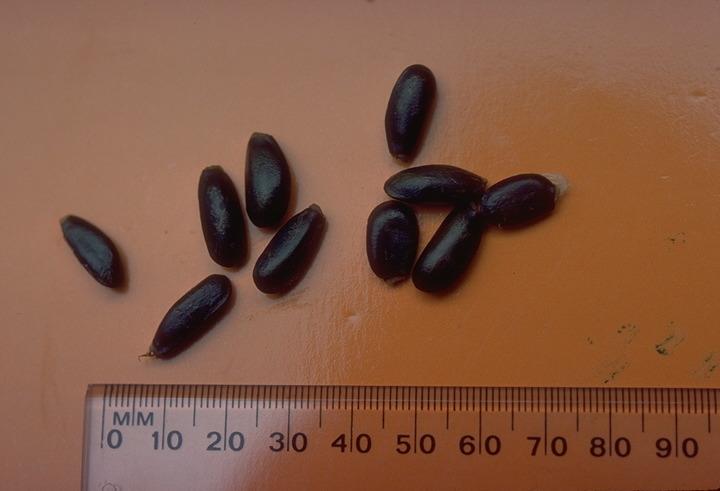
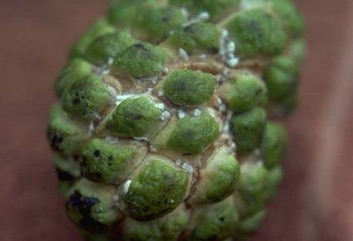
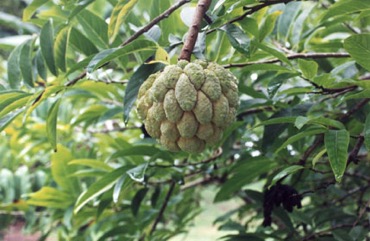
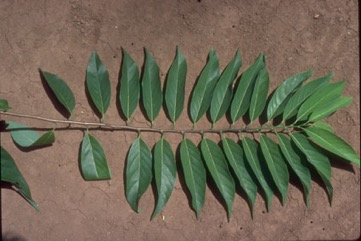
References
Sweetsop references Annona squamosa
Book Review: Classification of the Genus Annona with Descriptions of New and Imperfectly Known Species. 1988
Alexander, D.M., Scholefield, P.B., Frodsham, A., 1982, Some tree fruits for tropical Australia. CSIRO, Australia. p 47
Ambasta S.P. (Ed.), 2000, The Useful Plants of India. CSIR India. p 42
Anderson, E. F., 1993, Plants and people of the Golden Triangle. Dioscorides Press. p 202
Arora, R. K., 2014, Diversity in Underutilized Plant Species - An Asia-Pacific Perspective. Bioversity International. p 57
Ashton, M. S., et al 1997, A Field Guide to the Common Trees and Shrubs of Sri Lanka. WHT Publications Ltd. p 100
Awasthi, A.K., 1991, Ethnobotanical studies of the Negrito Islanders of Andaman Islands, India - The Great Andamanese. Economic Botany 45(2) pp274-280
Bajpai, O., et al, 2015, Tree species of the Himalayan Terai region of Uttar Pradesh, India: a checklist. Check List 11(4): 1718
Bandyopadhyay, S., et al, 2012, A Census of Wild Edible Plants from Howrah District, West Bengal, India. Proceedings of UGC sponsored National Seminar 2012
Barwick, M., 2004, Tropical and Subtropical Trees. A Worldwide Encyclopedic Guide. Thames and Hudson p 27
Bernegau 1911, Tropenpflanzer 15, p 23.
Bernholt, H. et al, 2009, Plant species richness and diversity in urban and peri-urban gardens of Niamey, Niger. Agroforestry Systems 77:159-179
Bircher, A. G. & Bircher, W. H., 2000, Encyclopedia of Fruit Trees and Edible Flowering Plants in Egypt and the Subtropics. AUC Press. p 32, p 29 (As Annona cinerea)
Bodkin, F., 1991, Encyclopedia Botanica. Cornstalk publishing, p 86
Bodner, C. C. and Gereau, R. E., 1988, A Contribution to Bontoc Ethnobotany. Economic Botany, 43(2): 307-369
Borrell, O.W., 1989, An Annotated Checklist of the Flora of Kairiru Island, New Guinea. Marcellin College, Victoria Australia. p 50
Bourret, D., 1981, Bonnes-Plantes de Nouvelle-Caledonie et des Loyaute. ORSTOM. p 38
Brouk, B., 1975, Plants Consumed by Man. Academic Press, London. p 170
Brown, 1951, Useful Plants of the Philippines. p 547
1977, Buah Buahan. Lembaga Biologi Nasional p 124
Burkill, H. M., 1985, The useful plants of west tropical Africa, Vol. 1. Kew.
Burkill, I.H., 1935, A Dictionary of the Economic Products of the Malay Peninsula. p 168
Chakraborty, S. & Chaturbedi, H. P., 2014, Some Wild Edible Fruits of Tripura- A Survey. Indian Journal of Applied research. (4) 9
Chandrashekara, U. M., 2009, Tree species yielding edible fruit in the coffee-based homegardens of Kerala, India: their diversity, uses and management. Food Sec. 1:361-370
Cheifetz, A., (ed), 1999, 500 popular vegetables, herbs, fruits and nuts for Australian Gardeners. Random House p 171
Chin, H.F., & Yong, H.S., 1996, Malaysian Fruits in Colour. Tropical press, Kuala Lumpur p 56
Chowdery, T., et al, 2014, Wild edible plants of Uttar Dinajpur District, West Bengal. Life Science Leaflets. 47:pp 20-36 http://lifesciencesleaflets.ning.com
Cooper, W. and Cooper, W., 2004, Fruits of the Australian Tropical Rainforest. Nokomis Editions, Victoria, Australia. p 19
Coronel, R.E., 1982, Fruit Collections in the Philippines. IBPGR Newsletter p 6
Cruz, I. M., et al, 2015, Edible fruits and seeds in the State of Mexico. Revista Mexicana de Ciencias Agricolas. Vol. 6. Num. 2 pp 331-346
Cundall, P., (ed.), 2004, Gardening Australia: flora: the gardener's bible. ABC Books. p 159
Darley, J.J., 1993, Know and Enjoy Tropical Fruit. P & S Publishers. p 3
Das, S. and De, B., 2013, Evaluation of Angiotension I-Converting Enzyme (ACE) inhibitory potential of some underutilized indigenous fruits of West Bengal using an in vitro model. Fruits, Vol. 68:499-506
Dastur, H., 1858, Useful Plants of India. p 41.
Dobriyal, M. J. R. & Dobriyal, R., 2014, Non Wood Forest Produce an Option for Ethnic Food and Nutritional Security in India. Int. J. of Usuf. Mngt. 15(1):17-37
Etherington, K., & Imwold, D., (Eds), 2001, Botanica's Trees & Shrubs. The illustrated A-Z of over 8500 trees and shrubs. Random House, Australia. p 96
Facciola, S., 1998, Cornucopia 2: a Source Book of Edible Plants. Kampong Publications, p 12, (Also as Annona cinerea)
FAO, 1993, Valor Nutritivo Y Usis en Alimantacion humana de Algunis Cultivos Autoctonos Subexplotados de Mesoamerica. FAO, Santiago, Chile. p 4
Flowerdew, B., 2000, Complete Fruit Book. Kyle Cathie Ltd., London. p 157
Focho, D. A., et al, 2009, Ethnobotanical survey of Trees in Fundong, Northwest Region, Cameroon. Journal of Ethnobiology and Ethnomedicine, 5:17
French, B., 1986, Food Plants of Papua New Guinea, Asia Pacific Science Foundation p 214
French, B.R., 2010, Food Plants of Solomon Islands. A Compendium. Food Plants International Inc. p 213
Garner, R.J., and Chaudhri, S.A., (Ed.) 1976, The Propagation of Tropical fruit Trees. FAO/CAB. p 223. 236
Ghorbani, A., et al, 2012, A comparison of the wild food plant use knowledge of ethnic minorities in Naban River Watershed Nature Reserve, Yunnan, SW China. Journal of Ethnobiology and Ethnomedicine; 8:17
Global Plants JSTOR
Hazarika, T. K., et al, 2012, Studies on wild fruits of Mizoram, India used as ethno-medicines. Genetic Resources and Crop Evolution. Published on line 03 February, 2012
Hearne, D.A., & Rance, S.J., 1975, Trees for Darwin and Northern Australia. AGPS, Canberra p 21, Pl 5 and Colour Pl 1
Hedrick, U.P., 1919, (Ed.), Sturtevant's edible plants of the world. p 56 (Also as Anona asiatica), p 57 (As Annona cinerea) and p 690 (As Xylopia glabra)
Hermano, A.J., 1934, Food values. Bureau of Sciences. Pop. Bull. 16
Hermandez Bermejo, J.E., and Leon, J. (Eds.), 1994, Neglected Crops. 1492 from a different perspective. FAO Plant Production and Protection Series No 26. FAO, Rome. p14
Heywood, V.H., Brummitt, R.K., Culham, A., and Seberg, O. 2007, Flowering Plant Families of the World. Royal Botanical Gardens, Kew. p 33
http://palaeoworks.anu.edu.au/Nuno_PhD/04.pdf re Timor
Hu, Shiu-ying, 2005, Food Plants of China. The Chinese University Press. p 398
Janick, J. & Paul, R. E. (Eds.), 2008, The Encyclopedia of Fruit & Nuts. CABI p 48
Jardin, C., 1970, List of Foods Used In Africa, FAO Nutrition Information Document Series No 2.p 121
John, L., & Stevenson, V., 1979, The Complete Book of Fruit. Angus & Robertson p 273
Kahlon, L. K. & Singh, R., 2019, Traditional knowledge & Dynamics of edible plants of primitive tribal group ‘Paudi Bhuyan’ with changing demography migration patterns in Northern Odisha. Indian Journal of Traditional Knowledge Vol 18(1), pp 7-15
Katende, A.B., Birnie, A & Tengnas B., 1995, Useful Trees and Shrubs for Uganda. Identification, Propagation and Management for Agricultural and Pastoral Communities. Technical handbook No 10. Regional Soil Conservation Unit, Nairobi, Kenya. p 106
Khanal, R., et al, 2014, Documenting abundance and use of underutilized plant species in the mid hill region of Nepal. ECOPRINT 21: 63-71, 2014
Kintzios, S. E., 2006, Terrestrial Plant-Derived Anticancer Agents and Plant Species Used in Anticancer research Critical Reviews in Plant Sciences. 25: pp 79-113
Kiple, K.F. & Ornelas, K.C., (eds), 2000, The Cambridge World History of Food. CUP p 1864
Krishen P., 2006, Trees of Delhi, A Field Guide. DK Books. p 69
Kumar, S. A., Manus, D. & Mallika, M., 2018, Impact of non-timber forest products on Forest and in Livelihood Economy of the People of Adjoining Areas of Jalpaiguri Forest Division, West Bengal, India. Int. J. of Life Sciences, 2018; 6 (2):365-385
Latham, P., 2004, Useful Plants of Bas-Congo province. Latham & DFID p 34
Latham, P. & Mbuta, A. K., 2014, Useful Plants of Bas-Congo Province, Democratic Republic of Congo. Volume 1. p 52
Latham, P. & Mbuta, A. K., 2017, Plants of Kongo Central Province, Democratic Republic of Congo. Volume 1. 3rd ed p 56
Lazarides, M. & Hince, B., 1993, Handbook of Economic Plants of Australia, CSIRO. p 21
Lembaga Biologi Nasional, 1977, Buah-Buahan, Balai Pustaka, Jakarta. p 124
Leon, J., 1968, Fundamentos Botanicos de los Cultivos tropicales. p 469
Llamas, K.A., 2003, Tropical Flowering Plants. Timber Press. p 61
Lorenzi, H., Bacher, L., Lacerda, M. & Sartori, S., 2006, Brazilian Fruits & Cultivated Exotics. Sao Paulo, Instituto Plantarum de Estuados da Flora Ltda. p 361
Macmillan, H.F. (Revised Barlow, H.S., et al) 1991, Tropical Planting and Gardening. Sixth edition. Malayan Nature Society. Kuala Lumpur. p 271
Mahony, D., 1991, Trees of Somalia. A Field Guide for Development Workers. Oxfam Research Paper 3. p 9
Manandhar, N.P., 2002, Plants and People of Nepal. Timber Press. Portland, Oregon. p 91
Maranon, J., Nutrititive mineral values of Philippines food plants. Philipp. Journ. Sci. 58:317-358
Martin, F. W., et al, 1987, Perennial Edible Fruits of the Tropics. USDA Handbook 642 p 18, p 80 (As Annona cinerea)
Mbuya, L.P., Msanga, H.P., Ruffo, C.K., Birnie, A & Tengnas, B., 1994, Useful Trees and Shrubs for Tanzania. Regional Soil Conservation Unit. Technical Handbook No 6. p 106
McMakin, P.D., 2000, Flowering Plants of Thailand. A Field Guide. White Lotus. p 105
Milsum, 1919, Bull. 29, Dep Agric. F.M.S. p 51
Morton, J. F., 1987, Fruits of Warm Climates. Wipf & Stock Publishers p 69
Murillo-A, J., 2001, Annonaceae of Colombia. Biota Colombiana 2(1): 49-51
Ochse, J.J., 1930, Fruits and Fruit Culture in the Dutch East Indies. p 25
Ochse, J.J., Dijkman, M.J., Soule, M.J. & Wehlburg,C., 1961, Tropical and Subtropical Agriculture. p 563
Omawale, 1973, Guyana's edible plants. Guyana University, Georgetown p 46
Pasha, M. K. & Uddin, S. B., 2019, Minor Edible Fruits of Bangladesh. Bangladesh J. Plant Taxon. 26(2): 299–313
Patiri, B. & Borah, A., 2007, Wild Edible Plants of Assam. Geethaki Publishers. p 18
Paul, A., 2013, Minor and uncultivated fruits of Eastern India, 2nd International Symposium on Minor Fruits and Medicinal Plants
Paz, F. S., et al, 2021, Edible Fruit Plant Species in the Amazon Forest Rely Mostly on Bees and Beetles as Pollinators. Journal of Economic Entomology, XX(XX), 2021, 1–13
Peekel, P.G., 1984, (Translation E.E.Henty), Flora of the Bismarck Archipelago for Naturalists, Division of Botany, Lae, PNG. p 181, 182
de Peralta, 1928, Philipp. Agriculturalist 17, p 333
Peters, C. R., O'Brien, E. M., and Drummond, R.B., 1992, Edible Wild plants of Sub-saharan Africa. Kew. p 54
Pham-Hoang Ho, 1999, An Illustrated Flora of Vietnam. Nha Xuat Ban Tre. p 243
Phon, P., 2000, Plants used in Cambodia. © Pauline Dy Phon, Phnom Penh, Cambodia. p 39
Plants of Haiti Smithsonian Institute http://botany.si.edu
Poponoe, W., 1920, Manual of Tropical and Subtropical fruits. Macmillan. p 177
Priyadi, H., et al, Five hundred plant species in Gunung Halimun Salak National Park West Java. A checklist including Sundanese names, distribution and use. CIFOR, FFPRI, SLU p 152
PROSEA (Plant Resources of South East Asia) handbook, Volume 2, 1991, Edible fruits and nut. p 71
Purseglove, J.W., 1968, Tropical Crops Dicotyledons, Longmans. p 625
Rajapaksha, U., 1998, Traditional Food Plants in Sri Lanka. HARTI, Sri Lanka. p 62
Raponda-Walker, A & Sillans, R., 1961, Les Plantes Utiles du Gabon. Editions Paul Lechevalier, Paris. p 63
Rashid, H. E., 1977, Geography of Bangladesh. Westview. p 343
Reddy, B. M., 2012, Wild edible plants of Chandrapur district, Maharashtra, India. Indian Journal of Natural Products and Resources. 3(1) pp 110-117
Ruiters-Welcome, A. K., 2019, Food plants of southern Africa. Ph.D. thesis. Univ. of Johannesburg p 17
Safford, W.E., 1905, Useful Plants of Guam. Contrib. US Nat. Herb., 9, p 185
Segura, S. et al, 2018, The edible fruit species in Mexico. Genet Resour Crop Evol (2018) 65:1767–1793
Selvam, V., 2007, Trees and shrubs of the Maldives. RAP Publication No. 2007/12 p 28
Sharma, B.B., 2005, Growing fruits and vegetables. Publications Division. Ministry of Information and broadcasting. India. p 4
Singh, G. K. & Ahirwar, R. K., 2013, An Ethnobotanical Survey for Certain Wild Edible Plants of Chanda Forest District Dindori Central India. International Journal of Science and Research. 6:14
Smith, A.C., 1981, Flora Vitiensis Nova, Lawaii, Kuai, Hawaii, Volume 2 p 39
Smith, P.M., 1979, Sweetsop, in Simmonds, N.W., (ed), Crop Plant Evolution. Longmans. London. p 302
Sp. pl. 1:537. 1753
Staples, G.W. and Herbst, D.R., 2005, A tropical Garden Flora. Bishop Museum Press, Honolulu, Hawaii. p 110
Steggerda, M., Some Ethnological Data Concerning One Hundred Yucatan Plants. Smithsonian Institution Anthropological Papers, No. 29
Sujanapal, P., & Sankaran, K. V., 2016, Common Plants of Maldives. FAO & Kerala FRI, p 37
Sukarya, D. G., (Ed.) 2013, 3,500 Plant Species of the Botanic Gardens of Indonesia. LIPI p 127
Suwardi, A. B., et al, 2020, Ethnobotany and conservation of indigenous edible fruit plants in South Aceh, Indonesia. Biodiversitas Vol. 21, No. 5, pp 1850-1860
Swaminathan, M.S., and Kochnar, S.L., 2007, An Atlas of Major Flowering Trees in India. Macmillan. p 25
Tankard, G., 1990, Tropical fruit. An Australian Guide to Growing and using exotic fruit. Viking p 102
Tate, D., 1999, Tropical Fruit. Archipelago Press. Singapore. p 22
Thaman, R.R., 1976, The Tongan Agricultural System, University of the South Pacific, Suva, Fiji. p 380
Thaman, R. R., et al, 1994, The Flora of Nauru. Atoll Research Bulletin No. 392. Smithsonian Institute p 89
Trimurti, 1924, Journ. Ind. Instit Sci. 7 p 232
Thaman, R. R, 2016, The flora of Tuvalu. Atoll Research Bulletin No. 611. Smithsonian Institute p 63
Tomar, A., Kumar, A., & Dubey, K., 2002, Underutilized Wild Edible fruits of Nutritional and Medicinal Value. J. Res. Educ. Indian Med., Vol XX1
Toppo, P. et al, 2016, Wild edible plants of Dhamtari district of Chhattisgarh, India. Van Sangyan Vol. 3, No. 4
Uphof, (As Annona cinerea)
Upreti, K., et al, 2010, Diversity and Distribution of Wild Edible Fruit Plants of Uttarakhand. Bioversity Potentials of the Himalaya. p 161
Van den Eynden, V., et al, 2003, Wild Foods from South Ecuador. Economic Botany 57(4): 576-603
van Roosmalen, M.G.M., 1985, Fruits of the Guianan Flora. Utrecht Univ. & Wageningen Univ. p 8
Vasquez, R. and Gentry, A. H., 1989, Use and Misuse of Forest-harvested Fruits in the Iquitos Area. Conservation Biology 3(4): 350f
Vasquez, Roberto Ch. & Coimbra, German S., 1996, Frutas Silvestres Comestibles de Santa Cruz. p 46
Walter, A. & Lebot, V., 2007, Gardens of Oceania. ACIAR Monograph No. 122. p 116
Williams, C.N., Chew, W.Y., and Rajaratnam, J.A., 1989, Tree and Field Crops of the Wetter Regions of the Tropics. Longman, p 139
Wong, K. C., 1995, Collection and Evaluation of Under-Utilized Tropical and Subtropical Fruit Tree Genetic Resources in Malaysia. JIRCAS International Symposium Series No. 3: 27-38
World Checklist of Useful Plant Species 2020. Royal Botanic Gardens, Kew
www.worldagroforestrycentre.org/sea/products/afdbases/af/asp/SpeciesInfo.asp?SpID=214
Young, J., (Ed.), 2001, Botanica's Pocket Trees and Shrubs. Random House. p 94
Yuncker, T.G., 1959, Plants of Tonga, Bernice P. Bishop Museum, Hawaii, Bulletin 220. p 116